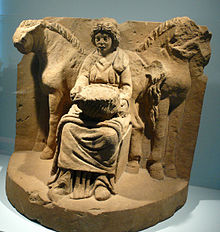{Tarot Equus} The High Priestess
Since my long-ago graduation from the Avante-Garde Uber Artsy
School, I've developed an aversion to posting my post-graduation work for
comment, aside from a few trusted loved ones. I stopped drawing and
painting for a while once I picked up full-time museum work, feel like I'm way
behind my peers and yadda, yadda, yadda, self-deprecating bullshit excuses.
I
have this irritating thing I do to myself as an artist. If you're also a
creator- maybe a writer, maybe a crafter or designer, you might be
familiar. I finish a piece, then stare at it until I hate it. I
don't really show it around, I never post a photo of it. I just sit and
hate on it, then move on to the next project. Sometimes that process
takes hours, but sometimes it takes months and therein lies the problem.
I can't keep doing that and expect to ever publish a long-term project like a
tarot deck. So here I am sharing one of my cards with you Lovelies.
Constructive critique is welcome, it's been a long time since I've gotten
it. This is a mix of Prismacolor pencils, black micron pens, and metallic
gel pens on paper, and it's hasn't been played with in Photoshop at all
(yet?). The original is 8.5x11. Photo taken amateurly with a 14 mpxl camera.
Tarot Equus is based heavily on the Rider-Waite-Smith
deck, and I've tried to match equine myths, legends, and lore from around the
world with the meaning of each card. This is my High Priestess. The
spirit of this card is the goddess Epona. Ok Gamers, yes, Epona is Link's
horse. BUT! Her namesake is a Goddess from Gaul (modern day France) who
was later adopted by the Roman cavalry and spread throughout the Empire.
Epona is a protectress of equines and they are
featured heavily in her depictions. Images
of her have been found in temples and stables from France to Germany.
Some sculptures depict her with a mare and foal, riding, taming a horse,
standing or sitting with a horse, or- as I've adopted for the card- seated
between two horses. This example is from 2nd century Germany and currently
resides in the Historic Museum of Bern. Epona is also frequently
portrayed with symbols of fertility such as the cornucopia, which almost landed
her as the Empress in my deck. She is frequently compared or conflated with the Welsh Rhiannon, who did become the Empress for this deck. There is also a popular notion in the modern
Pagan community that she and her horses are psychopomps- spirits that lead
recently deceased souls to the afterlife. If someone can point me to a source for that I'd really and truly appreciate it.
That brings me to Pamela Smith's High Priestess. She's pictured sitting enthroned between black and white temple pillars Boaz and Jakin, with a tapestry of pomegranates pinned up behind her, blocking the viewer's sight into the uknown lands beyond. She has the moon at her feet, a sacred scroll of the Torah in her hands, and the crown of Isis on her brow. She wears Virgin Mary blue and a cross on her chest. The High Priestess in earlier decks was also called The Papess, in honor of Manfreda Visconti, whose brief reign ended with her burning by the Catholic Church in 1300. Her family commissioned one of the first Tarot decks (as we know them) around 150 years later, the Visconti Tarot.
So, look close and you see where the symbols intertwine. Epona's mares have taken the place of the pillars. Tarot readers note that she is feeding Boaz, the pillar of passivity and mystery. Her dress is still in Virgin Mary blue, but is now styled after Gallo-Roman clothing from the 5th century. The lunar crown has become a crescent moon and horseshoe, with the full moon still represented in the sky, and in the reflection at her feet. I think these changes evoke Epona and stay true to the themes of the High Priestess.
I am purposely not getting into the meanings behind the card for the following reason: if you Lovelies choose to give me feedback, I'd like to know what comes to mind when you see this image, especially if you are not familiar with the Tarot. If you are familiar with the layers of meanings behind the card, I'd like to know how this measures up! Thank you much!



Comments
Post a Comment